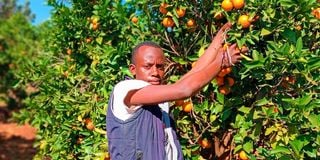Pixie farmers soldier on despite setbacks

Benson Mbithi harvests ripe pixies at his mother's farm in Makueni County.
What you need to know:
- Janet Mutua has more than 400 pixie and orange plants on her farm.
- It takes three to four years for the plants to mature and begin bearing fruits.
Makueni is known for producing juicy mangoes, lemons, oranges and many other fruits. Fruit farming thrives in this largely arid county.
Janet Mutua is one of the many residents of Makueni who make a living from growing oranges and pixie fruits.
On entering her orchard in Katulyani, Kibwezi West Constituency, one is greeted with a sight of ripe fruits hanging on the trees.
Ms Mutua has more than 400 pixie and orange plants on her two-acre piece, a venture she and her son Benson Mbithi began more than a decade ago.
“We started growing the fruits approximately 11 years ago,” says the 43-year-old.
Ms Mutua and her son grow pixie fruits, oranges, limes, mangoes, pawpaws and other fruits.
“We bought seedlings from a place called Kalamba in Matiliku. One seedling was Sh30 at the time,” Mbithi tells the Seeds of Gold.
Before planting the seedlings, Mbithi and his mother clear and plough the field.
“We ensure sure the field is tilled well. We use dung as manure from our cows,” he says.
After preparing the field, Ms Mutua, her son and a few labourers make holes for the seedlings.
The holes, Mbithi says, are ordinarily three feet wide and four feet deep.
According to Mbithi, well-decomposed manure and soil scooped from the hole are properly mixed after the holes are dug.
“We then pour water in the mixture that is now in the holes before planting the seedlings,” Ms Mutua says.
It takes three to four years for the plants to mature and begin bearing fruits. One pixie plant produces more than 50 kilogrammes of fruits in one season.

Benson Mbithi harvests ripe pixies at his mother's farm in Makueni County.
“A plant can produce two cartons of fruits, each weighing 27 kilos,” he says, adding that oranges tend to be the bigger and heavier of the two fruits.
A carton of oranges is 30 to 40 kilogrammes. One tree produces three to four boxes.
Producing pixie fruits, oranges and the others comes with a myriad of challenges, including deadly diseases and destructive pests.
“We get good yields in some seasons but there are years things are never that rosy,” Mbithi says.
Ms Mutua and her son use pesticides and other chemicals to fight the pests and diseases.
“We spray as soon as we discover an infestation. Scales are common in the farm, but spraying helps eradicate them,” she tells Seeds of Gold.
With Makueni largely being a dry region, the two farmers also grapple with problems associated with drought and lack of water.
Pumping water from the closest river to the farm is expensive.
“During such moments, we require a lot of fuel. Unfortunately, prices of petroleum products are high. This eats into our profits,” she says.
During dry spells, the fruits harvested are usually small and of low quality. Finding buyers can be problematic. Some customers reject the fruits and those who pay quote very low prices.
The quantity of harvest varies from season to season, depending on rain and other factors.
Most customers troop to the farm for the fruits. A kilogramme of oranges goes for Sh60.
For pixies, however, a kilo is Sh150 or even more.





